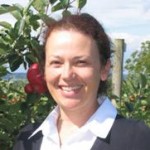With the first plantings of Cosmic Crisp™ WA 38 due in spring 2017 it is important to know what training and pruning techniques, pollinizers, and rootstocks are most appropriate for this new variety. WSU research plantings provide growers the opportunity to see Cosmic Crisp™ WA38 growth habit, fruit type and recommended horticulture in the field before they plant. Dr. Stefano Musacchi, associate professor of tree fruit physiology and management with Washington State University and Tom Auvil from the Washington Tree Fruit Research Commission shared horticultural tips for this new WSU variety at a spring field day. In case you missed the field day, we’ve written up all the information from the event and shred it below. Watch for more information at June and September field days.
Growth Habit and Fruit Type
Habit. WA 38 Brand WA 38 cv is a type 4 tree like a Granny Smith. It can have long branches and produce a lot of blind wood. It is a reasonably vigorous variety which tends to settle down once it begins to crop.
Bloom. WA 38 produces a lot of secondary lateral blooms. Laterals can be 40% of the total cluster. Tree fruit have two types of buds, terminal and lateral buds. A terminal, sometimes called the apical bud, is located at the tip of a shoot. A lateral bud forms along the developing shoot at the base of the leaf blade. Lateral flower buds bloom after the terminal buds and in a cool spring many lateral buds will lengthen the time between primary and secondary bloom.
The bloom period for WA 38 is mid to late season, the same period as Snowdrift pollinizers. There is little apparent difference in bloom timing on 1st versus 2nd and 3rd year wood compared to some varieties which tend towards a more consolidated bloom.
Fruit type. WA 38 is a bi-color type fruit and so it needs uniform good light exposure to develop a good overcolor. The training system you choose will affect the amount of light that reaches lower sections of the canopy and consequently the uniformity of color in the fruit.
It is important to match the tree training, pruning and thinning techniques as well as pollinizers to the tree habit. “Each variety has a different story depending on the habit and fruit characteristics,” Musacchi explains.
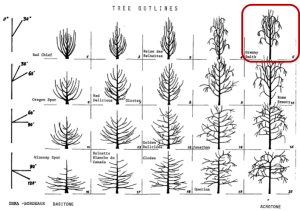
Training System for WA 38
Musacchi and Auvil tested three tree training techniques for Cosmic Crisp: Bi-Axis, Spindle, and European V. This trial will was established in 2013 and will continue through 2016. Here are some preliminary results.
Bi-Axis
Bi-Axis is a training system based on two axes that can be obtained by the growers heading back the tree in the field or budding two buds on the rootstock in the nursery.
The bi-axis in our trials was produced in field by initially heading back the tree to a 1.5 foot high trunk immediately after planting. After shoots began to grow the stem was headed back again at aproximately 1 foot removing the strong vertical shoot and leaving two shoots in the lower portion of the trunk that generally exhibit a more open crotch angle.
Nurseries achieve two uniform axes by double chip budding (Bibaum® tree). This technique has been patented by Vivai Mazzoni in Italy and the USA.
In both cases the two axes are grown as small independent spindle trees. Compared to a single spindle two axes tend to reduce vigor. Like the spindle system bi-axis systems generally have high early yield and uniform light exposure. This system doubles the axes without doubling the tree cost.
WA 38 has done well in a Bi-Axis system. The Bi-Axis provides good light penetration for uniform color and thin fruiting walls appropriate for mechanical pruning and harvest. Bi-Axis WA 38 would be at 4 x 10 foot to 4 x 11 foot spacing in most soils. Bi-Axis might not be appropriate for poor soils.
Advantages to the Bi-Axis System for WA 38 include:
- Good fruit coloring. “We like systems [for WA 38] which expose the fruit to the light,” Dr. Musacchi explains. This system has a thinner canopy which is beneficial for this variety like most bi-color varieties which need to color.
- Ability to mechanically prune and harvest. Thin fruiting walls will be critical for mechanical harvest. Long branches tend to be sucked into the harvest mechanism damaging the fruit. “It is really important we take into account mechanical harvest as we build our next orchards,” Auvil explains.
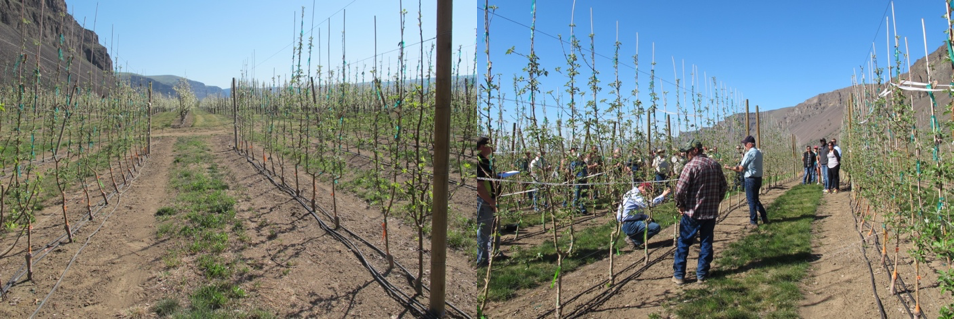
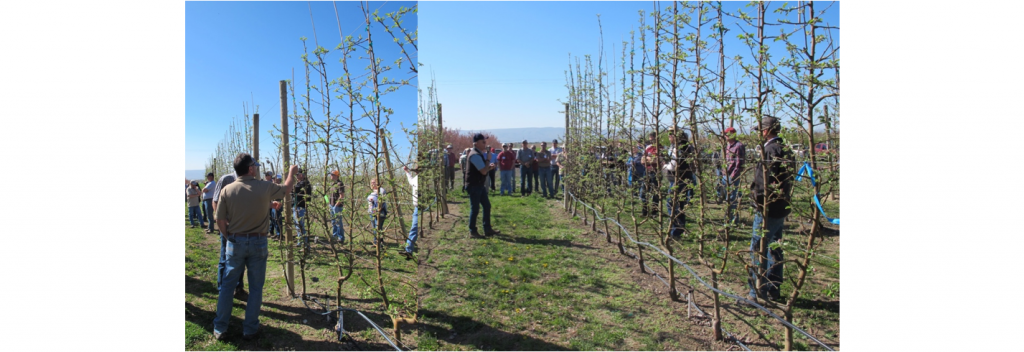
Spindle
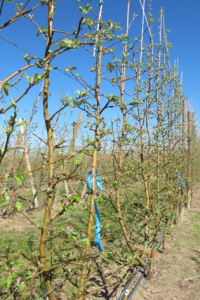
Spindle systems are designed to maximize profitability through early yield, improved fruit quality, reduced spraying, pruning and training costs as well as the ability to turn an orchard over quickly. Trees are planted at high density on dwarfing rootstock. There are no permanent limbs within the canopy but instead renewal cuts are made each year to remove limbs too big for the canopy (Limbs bigger than 30% of the diameter of the trunk should be removed).
WA 38 in a spindle training system also provides good light penetration for fruit coloring and is conducive to mechanical harvest. WA 38 spindle spacing would be 3 x 10 foot to 3 x 12 foot.
Advantages for a Spindle System for WA 38 include:
- Good fruit coloring. WA 38 on Spindle tends to color well throughout the canopy which is important for this bi-color fruit. “With thin fruiting walls we can get 60-80% with good color in the first harvest pass,” Auvil noted.
- Ability to mechanically harvest and prune. Mechanical pruning is advantageous in WA 38 because it helps to minimize the blind wood tendency of this variety. Thin vertical canopies work well for mechanical pruning.
European V.
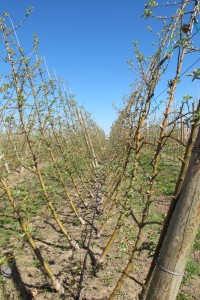
A European V system consists of staggered spindle trees grown at a 15° angles. This IS NOT a Auvil Fruit Company intensive V system where limbs are trained to a wire. Instead European V pruning is conducted similar to a Spindle. For WA 38 researchers are working with a 1.5 feet distance on the row and 10-11 feet between tree rows.
Disadvantages to the European V system for WA 38 include:
- Difficulty of pruning inside the V. In a blind wood-prone variety like WA 38 it is important to be able to properly prune. ‘Clicking,’ or tipping the ends of branches to break apical dominance and induce bud swelling, is difficult to perform on the inside of the V.
- Difficulty of mechanical pruning the V. It is not possible to mechanically prune the inside of the V, nor is it easy to mechanically prune the outside of the V due to the angle of the canopy.
- The V shape canopy creates shade in the lower parts of the canopy. Because WA 38 is a bi-color type fruit it is important to have good light exposure. “In a European V all the fruit inside the V will be effected by shade from the leaves.” Musacchi explain
Please note that in this trial we are not using a cooling system nor reflective fabric. The European V- system will benefit from the reflective fabric more than the vertical system. Cooling systems can reduce the sunburn problems observed with summer pruning in this trial.
Pruning Techniques for WA 38
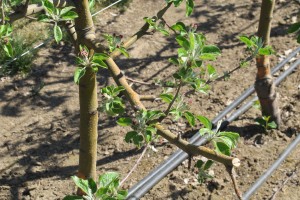
‘Click’
‘Click’ is a method of tipping the branches of one-year-old wood. This helps to minimize blind wood which WA 38 is prone to. Tip the end of one-year-old wood and come back the following year to tip again leaving two to three buds.
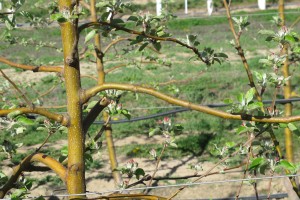
Bending
Bending is often used to reduce the vigor of a branch in tall spindle systems. However, because Cosmic is a type 4 tree (Lespinasse classification) bending tends to create blind wood. Musacchi and his team have found that bending tends to result in 2-3 more nodes of blind wood than clicking type pruning methods. This blind wood not only reduces fruiting potential but also exposes the branch to sun and sunburn due to the fruit orientation. “One tip to remember from this field day is don’t use bending in WA 38,” researchers say.
Girdling and Notching
Apples produce auxin – a plant growth hormone, in their growing meristems and shoot tips. Auxins flow down inhibiting bud break for a distance below the growing shoot tip. A shallow cut into the cambium and phloem interrupts the flow of auxins to the dormant buds and these buds will start to grow. “The girdle should be very light, just the bark and the green part [cambium], about a millimeter,” says Musacchi. The best time to girdle or notch is in late February to the beginning of March when the sap is starting to flow. During this period the tree should heal within 2-3 weeks. Girdling and notching can be very effective for WA 38 to reduce its tendency towards blind wood. Girdling should be done approximately every foot of the trunk on second year trees. It is critical not to girdle too deeply. “Don’t cut the wood. You can break the tree,” Musacchi explain.
Mechanical Pruning
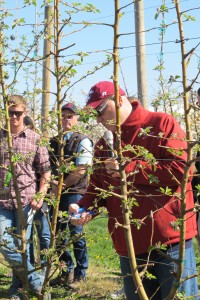
This is the second year researchers have mechanically pruned the Cosmic Crisp block. Mechanical pruning has helped minimize blind wood. Short limbs are close to the tree and provide good light exposure. “Every cut we made has buds opening,” Musacchi explains, “This is what we want. It is minimizing blind wood.”
It is important to do your thinning after pruning when you prune mechanically. When you thin second you can identify and remove fruit injured by mechanical pruning.
Summer pruning
This technique can be used to remove shoots that are growing too much. It can be performed by pinching the shoot apex to reduce shoot elongation with similar results to the mechanical pruning.
Manage Bloom for Sufficient Fruit
Fruit set is lower in WA 38 than other varieties. Many varieties set 4-5 fruits per cluster. WA 38 tends to set only one fruit per cluster, occasionally two, similar to SweeTango. It is important to be very cautious when thinning WA 38 in order to maintain sufficient fruit set. “I would not recommend thinning the first crop,” Auvil explains. Mechanical or other thinning might reduce the crop too much the first year. In subsequent years growers will want to be cautious and thin WA 38 lightly.
Pollinizers
WA 38 tends to bloom mid to late season during the same period as Snowdrift pollinizers. Manchurian crabapples are not a good fit because they flower too early. Manchurian also matches one incompatibility allele with WA 38. As such only 50% of the Manchurian pollen would be effective for pollination of WA 38. Place pollinizers every 30 feet, approximately every trellis frame in the orchard.
Rootstocks
WSU is evaluating WA 38 on two different rootstocks M.9 Nic 29 and G41. At the Roza orchard in Prosser, trees on both rootstocks look good. G41 is more consistent in canopy volume and height. Roza has a sandy loam soil.
At the Sunrise Orchard in Rock Island, WA the soils are exhibiting apple replant on its lighter, variable texture soils. Overall trees at Sunrise show less canopy volume than trees at Roza. Trees on G41 are larger with more consistent canopy volume and height than M.9 Nic 29.
This is an ongoing trial. Remember the suggestions above are preliminary. Watch for more information at June and September field days. We will continue to update this page as we learn more.
Contact Information
Tianna DuPont, Tree Fruit Extension Specialist
Associate Professor,
Endowed Chair – Tree Fruit Physiology and Management
Project Manager
Tree Fruit Research Commission
Professor
Horticulture
References
Dorigoni, A., Lezzer, P., Dallabetta, N., Serra, S., Musacchi, S., 2011. Bi-axis: An alternative to slender spindle for apple Orchards. Acta Hort. 903, pp. 581-588.
Lauri, P., Laurens, F. 2005. Architectural types in apple (Malus x domestica). Crops: Growth and Biotechnology. pp 1300-1313.
Lepinasse, Y. 1985. Inheritance of Two Agronomical Characteristics in the Apple Tree: Compact type habit and fruit color. Acta Horticulture 159.
Musacchi S., 2008. Bibaum®: A new training system for pear orchard. Acta Hort. 800: 763-768.
Musacchi S., D. Bucci, V. Ancarani, F. Gagliardi and S. Serra, 2014. Investigation of ‘Modì®’ Habitus in Relation to Training Systems. Acta Hort. 1058: 121-128.


